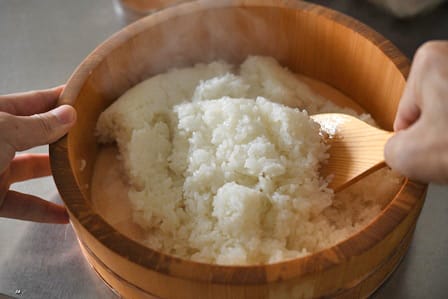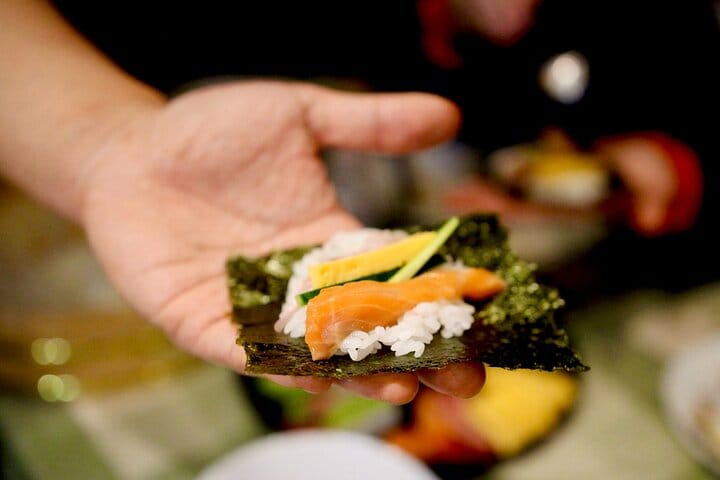Sushi is a representative of Japanese cuisine that is loved around the world. Anyone interested in Japan has probably tried it at least once, right? Of course, I love sushi so much that I could eat it every day!
Actually, there are various types of sushi. Nigiri sushi is the most famous, but there are also rolled sushi, pressed sushi, and scattered sushi. Nigiri sushi requires great skills, and it takes 10 years of training to become a fully qualified sushi chef.
On the other hand, hand-rolled sushi and rolled sushi are dishes that can be easily made at home and are familiar at home meals. In this article, I will explain in detail the differences between hand-rolled sushi and rolled sushi, how to make them, and recommended ingredients.
The Difference Between Hand-Rolled Sushi and Rolled Sushi
Hand-rolled sushi and rolled sushi are types of sushi where sushi rice and ingredients are wrapped in seaweed (nori) sheets. Both allow for a high degree of freedom in choosing ingredients, making them popular for party menus and home cooking. They originally started as a hidden menu item at sushi restaurants but are now widely enjoyed. They are especially known as a dish that children can enjoy.
The difference between hand-rolled sushi and rolled sushi lies in how they are rolled and their shape. Rolled sushi is generally rolled using a bamboo mat called a "sudare." Rolled sushi made by a top chef has a beautiful, uniform thickness throughout.
On the other hand, hand-rolled sushi is rolled by hand directly holding the nori sheet while wrapping the sushi rice and ingredients. The shape is narrower on one end and wider on the other, like an ice cream cone.
Things Needed for Hand-Rolled Sushi
Sushi Rice
Source: Shirogohan.com
Sushi rice (sumeshi) is the base for sushi, made by mixing cooked rice with vinegar, sugar, and salt. The slightly sour and sweet sushi rice goes perfectly with sashimi. While the sushi rice mixture varies by region and restaurant, a general ratio is 4 tablespoons of vinegar, 4 tablespoons of sugar, and 1.5 teaspoons of salt per 3 rice cups (about 1kg) of cooked rice.
A sushi rice tub (oke) is typically used to make sushi rice, but a large shallow bowl works too. A rice paddle called a "shamoji" is also needed. Transfer freshly cooked rice to the bowl, then mix in the vinegar, sugar, and salt mixture. Initially mix from the bottom with large strokes, then cut horizontally with the shamoji once partially mixed.
Favorite Ingredients
For hand-rolled sushi, you can freely combine any ingredients you like. Here is a list of popular ingredients, but finding your own favorite combination is part of the fun of hand-rolled sushi!
- Tuna
- Salmon
- Negitoro (chopped tuna with green onions)
- Shrimp
- Eel
- Ikura (salmon roe)
- Tuna mayo
- Crab stick (surimi)
These ingredients can be used raw, or cooked by grilling, boiling, etc. Wrapping them with egg, avocado, cucumber and other fish-friendly ingredients makes for a vibrant variety of flavors.
In Japan, sushi using non-fish ingredients like natto (fermented soybeans) or kanpyo (dried gourd shavings) are also popular. The California roll with avocado and fried shrimp is easy to make at home too. My personal favorite is a hand roll with tuna, shiso leaves, and avocado - refreshingly delicious on a hot summer day.
Nori Seaweed Sheets
Nori seaweed is an essential ingredient for wrapping the outside of hand-rolled sushi, and its freshness directly affects the flavor and texture. When choosing nori, first look at the surface - fresh nori has a sheen. Darker-colored nori also tends to be more flavorful.
Nori harvested in winter has especially concentrated umami flavors and is highly recommended. While quality nori can be hard to find abroad, Japanese products can be purchased online.
How to Make Hand-Rolled Sushi
Cut the Nori into Quarters
To make hand-rolled sushi, first the nori sheet needs to be cut into an appropriate shape and size. Usually cutting one sheet in half or thirds makes it easier to roll. It's important to cut it to a size that can fully wrap all the ingredients. While nori can be cut with scissors, fresh nori can be torn by hand along the perforated lines for a clean cut.
Also, cutting one end at an angle and rolling with the longer side up can make it easier to roll the hand roll. Pre-cut nori in temaki sushi size may be available at some supermarkets.
Place the Sushi Rice on the Nori
Nori sheets have a smooth side and a rough side. When making hand rolls, place the sushi rice on the rough side, which helps grip the rice and ingredients in place without slipping.
On a cutting board or plate, place the nori sheet rough-side up and make a triangular mound of sushi rice slightly to the left of center. Use your hands to gently flatten and even out the height of the rice mound. For a typical hand roll size, use about twice as much rice as a nigiri sushi portion.
Add the Fillings
After spreading out the sushi rice on the nori, it's time to add your desired fillings. Cut the fillings into thin strips and arrange them lengthwise down the center of the rice for an even roll. Be careful not to overfill, which makes rolling difficult and could cause the roll to fall apart.
The arrangement of the fillings also matters for appearance and flavor balance. For example, pairing white fish with bright green vegetables makes for a visually appealing roll.
Roll it Up
With the fillings in place, it's finally time to roll up the hand roll. First, grip the bottom left corner of the nori and fold it up slightly over the filling. Then start rolling by gently wrapping the nori around the filling, going a little at a time to form the classic cone shape of a temaki roll.
Grip the nori firmly to keep the fillings from falling out as you go. Once rolled up to the top right corner, the hand roll is complete! Dip in soy sauce or wasabi to taste and enjoy this fun, handheld sushi snack.
Experiencing Hand-Rolled Sushi in Japan
While hand rolls are convenient to make at home, for a more authentic temaki sushi experience, consider taking a workshop class in Japan. These provide fresh, quality ingredients and instruction directly from a sushi chef, allowing you to enjoy the fun of hand-rolling your own sushi. It's a great chance to pick up rolling tips while immersing yourself in Japanese food culture.
Hand-rolled Sushi Temaki Zushi Workshop in Tokyo
Source: TripAdvisor
The Hand-rolled Sushi Temaki Zushi Workshop offers a 2-hour class in Tokyo where you can make your own temaki sushi. It includes a demo of how to prepare sushi rice and instructions for hand roll prep. Choose your favorite fish from an array of fresh ingredients to create your ideal hand rolls.
You'll also learn how to make an accompanying soup broth called “osuimono” that pairs well with hand rolls. The cost is $50 per person, which includes 8-10 hand rolls, 2 drinks, and the osuimono soup. The location is just a 1-minute walk from Sumiyoshi Station on the Tokyo Metro Hanzomon Line or Toei Shinjuku Line.
Tour details: https://www.viator.com/tours/Tokyo/Temaki-Zushi-hand-rolled-sushi-workshop-experience/d334-455470P1
Sushi & Sake Tasting Cooking Class with Visit to Local Supermarket in Tokyo
Source: Official website
This unique hand-roll sushi class offers a cultural experience along with the cooking lesson. A friendly guide provides insight about ingredients in English as you visit a local supermarket to hand-pick items for your sushi rolls. A highlight is a sake tasting paired with the sushi in a relaxed, social atmosphere.
The 4-hour experience costs ¥14,000 and includes the cooking class, side dishes, drinks, and lunch. It's conveniently located near Iriya Station, close to Asakusa and Kappabashi kitchen town for sightseeing afterward. A kid's room is available, making it family-friendly too.
Tour details: https://www.magical-trip.com/product/20236e73-beca-4dd0-a514-3022b62840f5





